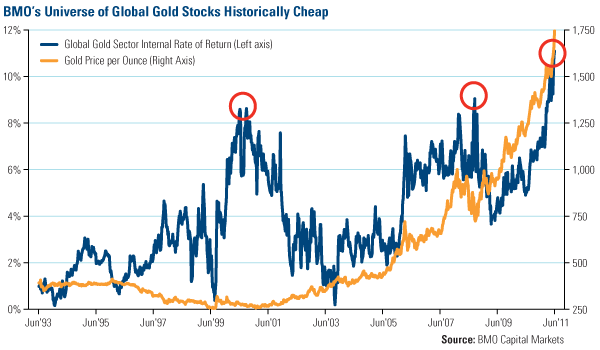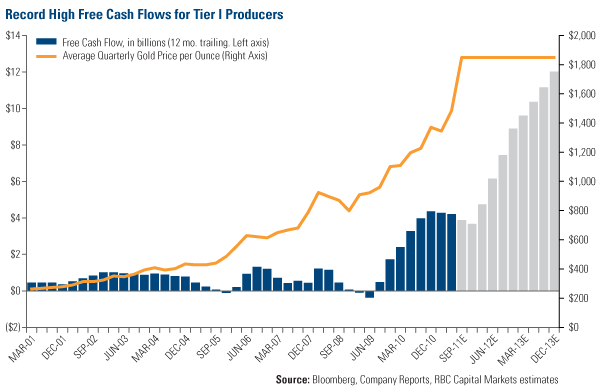One market trend that seems to be attracting more and more attention is the large performance gap between gold bullion and gold stocks. The price of gold bullion has increased roughly 28 percent in 2011, while the S&P/TSX Gold Index is down [about] 1 percent. [Let me convey why that is the case.] Words: 1001
So says Frank Holmes (www.usfunds.com) in an article* which Lorimer Wilson, editor of www.munKNEE.com (It’s all about Money!), has further edited ([ ]), abridged (…) and reformatted below for the sake of clarity and brevity to ensure a fast and easy read. Please note that this paragraph must be included in any article re-posting to avoid copyright infringement. Holmes goes on to explain:
BMO Capital Markets have offered one reason behind the performance gap, saying:
“The rate of change in the gold price has been high over the past decade, perhaps too high for investors to gain confidence in that price as sustainable for an equity investment decision” 9and while it was hard to imagine gold prices could sustain a $1,000 an ounce levels five years ago,) “now it’s hard to see the gold price falling to that level.”
Using the implied value of a defined group of global gold stocks, BMO calculated the internal rate of return to measure how gold stocks have underperformed compared to the yellow metal. Over a period of nearly 20 years, BMO’s group of global gold stocks has never been this inexpensive. Only twice—during the Tech bubble in 2000 and the financial crisis of 2008—has the internal rate of return compared so closely with the price of gold bullion.

RBC Capital Markets also sees potential in unpopular, undervalued gold equities and urges readers to take “a fresh look” at gold companies. RBC says gold companies currently have margins that are at record highs and it believes margins could be approximately $1,200 an ounce for the next 12 to 24 months. This is substantially higher than the 10-year average of $320 an ounce. Comparatively, many current projects were economically sound at $700-$1,000 per ounce gold prices, creating $300-500 an ounce margins.
Right now, BMO calculates the total cost to produce an ounce of gold at roughly $900 an ounce, while the company can turn around and sell that ounce for upwards of $1,400. This puts margins near 40 percent, roughly twice what they were in 2007 and four times higher than in 2000.
Increased profit margins put more money in gold company coffers and this is reflected in the unprecedented amount of free cash flow (FCF), RBC says. The firm says the industry has reached an inflection point with a “substantial wave of free cash flow” coming over the next 1 to 2 years.
You can see this incredible increase in Tier 1 producers, such as Barrick, Goldcorp, Kinross and Newmont Mining. Looking at their trailing 12 months of free cash flow over 10 years, FCF never rose above $2 billion. However, following the trend in gold prices, FCF among these Tier 1 companies stair-stepped up to $4 billion.

Looking forward over the next few years, RBC estimates that if the price of gold remains at $1,850, FCF should stair-step even further, reaching nearly $12,000 by the end of December 2013. BMO estimates the global gold companies will accumulate net cash of $120 billion by 2015 if gold prices remain elevated.
Rising FCF is especially relevant to shareholders, as it allows the gold company to use that money to invest in projects that should enhance shareholder value. This could include pursuing new projects, making acquisitions, reducing debt or paying dividends. Many gold companies are opting for the latter and increasing dividends but these increases haven’t kept up with the pace of rising earnings. The average payout ratio was roughly 20 percent in 2008 but currently sits around 10 percent in 2011.
BMO says, “A dividend policy linked to the financial performance of the company offers investors additional leverage to the gold price. The provision of a meaningful and sustained dividend has the potential to broaden investor appeal and to instill fiscal responsibility for management.”
BMO says gold stocks are currently trading at historically cheap levels, which the company sees as an opportunity investors can take advantage of.
RBC attempts to quantify that opportunity by saying:
“if gold prices remain elevated and/or investors accept a higher long-term gold price, we could see 25-50 percent upside in equities.”
*http://www.usfunds.com/investor-resources/investor-alert/
Related Articles:
- Gold Mining Stocks Are CHEAP Compared to Price of Gold: So far in 2011 gold prices have increased [approx. 8] percent.. while the stocks of gold [mining] companies in the HUI have… declined 13%…[As such,] this year’s carnage has created a substantial opportunity to buy healthy gold mining companies at their second-cheapest level in nearly 30 years compared to gold bullion. [Let me explain.] Words: 1265
- Negative Sentiment Suggests Buying Gold & Silver Stocks NOW: Relative to gold, gold stocks are now +30% cheaper than they were at the bottom of [the previous] 20 year long bear market [and that, in addition to the current negative sentiment for the PM sector, suggests that now might be an ideal time to get your fair share of PM stocks and/or their associated warrants. Let’s take a look at some charts that support my point of view]. Words: 908
- NOW is the Best Time to Buy Gold Stocks! Here’s Why: The precious metals correction is here. Gold and silver are down… and gold and silver stocks, as should be expected, are down even more but…have been hit much harder than they should have been. As a result, right NOW is the best time [we have seen] to buy gold stocks in more than two years and they’re poised to make another run of 30% in the next few months. Here’s why. Words: 767
Editor’s Note:
- The above article consists of reformatted edited excerpts from the original for the sake of brevity, clarity and to ensure a fast and easy read. The author’s views and conclusions are unaltered.
- Permission to reprint in whole or in part is gladly granted, provided full credit is given as per paragraph 2 above.
- Submit a comment. Share your views on the subject with all our readers.
 munKNEE.com Your Key to Making Money
munKNEE.com Your Key to Making Money